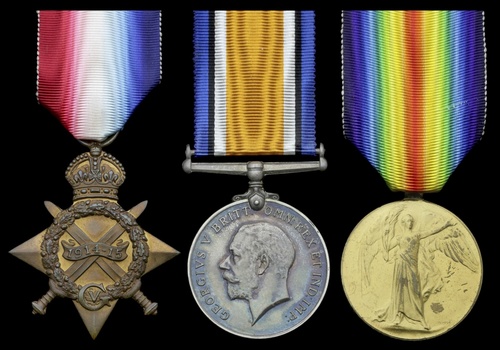Auction: 20002 - Orders, Decorations, Medals & Space Exploration
Lot: 303
A fine group of three awarded to Seaman A. J. Bowles, Royal Naval Reserve, who was present during the fierce engagement in the South Atlantic between the Carmania and the Cap Trafalgar on 14 September 1914, the first battle in history between converted ocean liners
1914-15 Star (3008B. A. J. Bowles, Smn., R.N.R.); British War and Victory Medals (3008B. A. J. Bowles. Smn. R.N.R.), in original card box of issue with full length silk ribbons, extremely fine (3)
Arthur John Bowles was born on 14 September 1883 at Southwick, and lived before the outbreak of the Great War at 57 Colne Street, Brighton. He joined the R.N.R. on 1 April 1905 and witnessed service aboard Swiftsure and Hogue, being at one time recommended for promotion to Leading Seaman. Posted to Excellent and Carmania during the Great War, he was discharged to shore on 6 August 1915 in consequence of 'action between that ship (Carmania) and Cap Trafalgar' (Service Record, refers).
The destruction of the converted German passenger ocean liner SMS Cap Trafalgar by the RMS Carmania was the first battle in history between ocean liners (Castles of Steel: Britain, Germany, and the Winning of the Great War at Sea, refers), the latter being the only armed merchant cruiser to sink a similar vessel during the war. Engaged in a furious action on 14 September 1914, the Carmania and Cap Trafalgar pounded each other with 4.1 inch and 4.7 inch shellfire for two hours off the Trindade and Martin Vaz archipelago in the South Atlantic. The circumstances are described in vivid detail by The Illustrated War News on 18 November 1914:
'Both the captains of the Cap Trafalgar and the Carmania had realised that to fight a successful action, their respective vessels required plenty of room; so, the captains had separately steamed several miles from the outcrop of Trindade in order to gain the space required. The Cap Trafalgar also sent out encoded German messages, announcing the engagement with the Carmania, and the position as 35 degrees west, 26 degrees south, with a NNW heading. Then the two ships turned towards each other and began to fight, the Carmania firing too early and thus allowing the Cap Trafalgar to land the first blow.
Carmania fared worse than her opponent in the ensuing two hours, being hit 79 times, was holed beneath the waterline, and had her bridge totally destroyed by shellfire. However, as the range closed, her own guns began to inflict damage, and fires broke out on both ships, sailors lining the rails and firing machine guns at their opposite numbers as the ships came within a few hundred yards of each other. Neither ship had the fire control systems or ammunition hoists of a modern warship, so the action was fought in the style of Nelson's day, with ammunition being brought to the guns by hand and the guns firing as the target bore.'
Veering away, the Cap Trafalgar heeled over to port and was forced to lower her lifeboats. A shell below the waterline had ruptured several compartments and she began to sink fast. Things were little better aboard Carmania; she listed severely as fires burned and destroyed the navigation and communication equipment on her bridge. Aware of the presence of other enemy vessels in the area, notably the Kronprinz Wilhelm, captain Noel Grant gave the order to turn away and head south, hoping to rendezvous with a British cruiser. By the time she was rescued the following day, Carmania was barely seaworthy and was slowly escorted into Pernambuco by the Royal Navy. Meanwhile the 279 survivors of the Cap Trafalgar were rescued by the collier Eleonore Woermann and taken to Buenos Aires. Most were later interned on the Argentine island of Martin Garcia (The Hamburg South America Line, refers).
It is believed that the battle cost the lives of 51 German sailors aboard Cap Trafalgar, including that of Captain Julius Wirth. Carmania suffered 9 men dead and 27 wounded (World War 1: A Student Encyclopedia, refers), including Seaman Bowles. Later found medically unfit for further service, he was pensioned off and likely returned home to Brighton. Following extensive repairs at Gibraltar, Carmania made several more Atlantic patrols hunting German colliers and supply ships, and later participated as a troopship during the Gallipoli campaign. After the war she returned to the transatlantic run and remained in service until 1931, being eventually sold for scrap the following year.
Subject to 20% VAT on Buyer’s Premium. For more information please view Terms and Conditions for Buyers.
Sold for
£550
Starting price
£80







